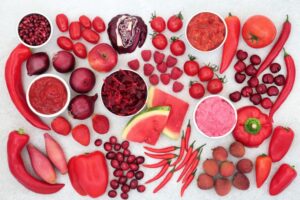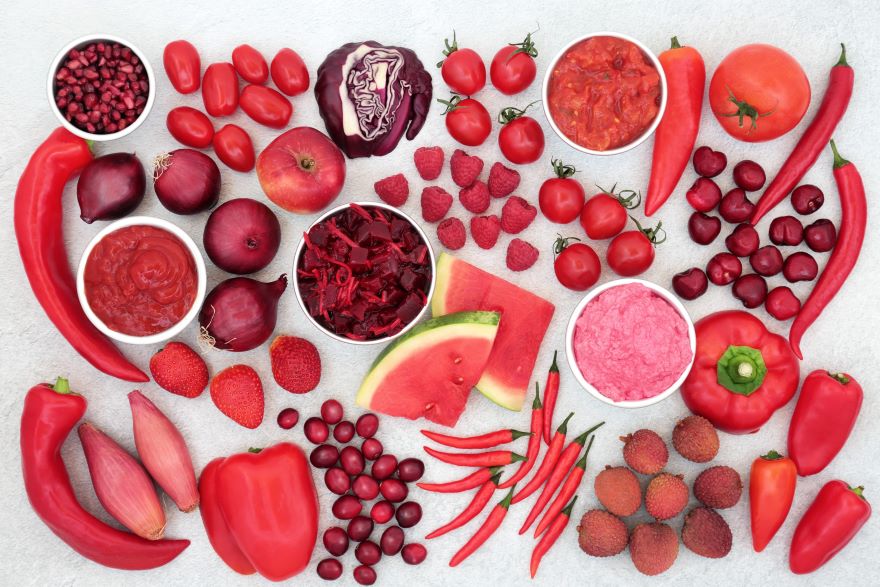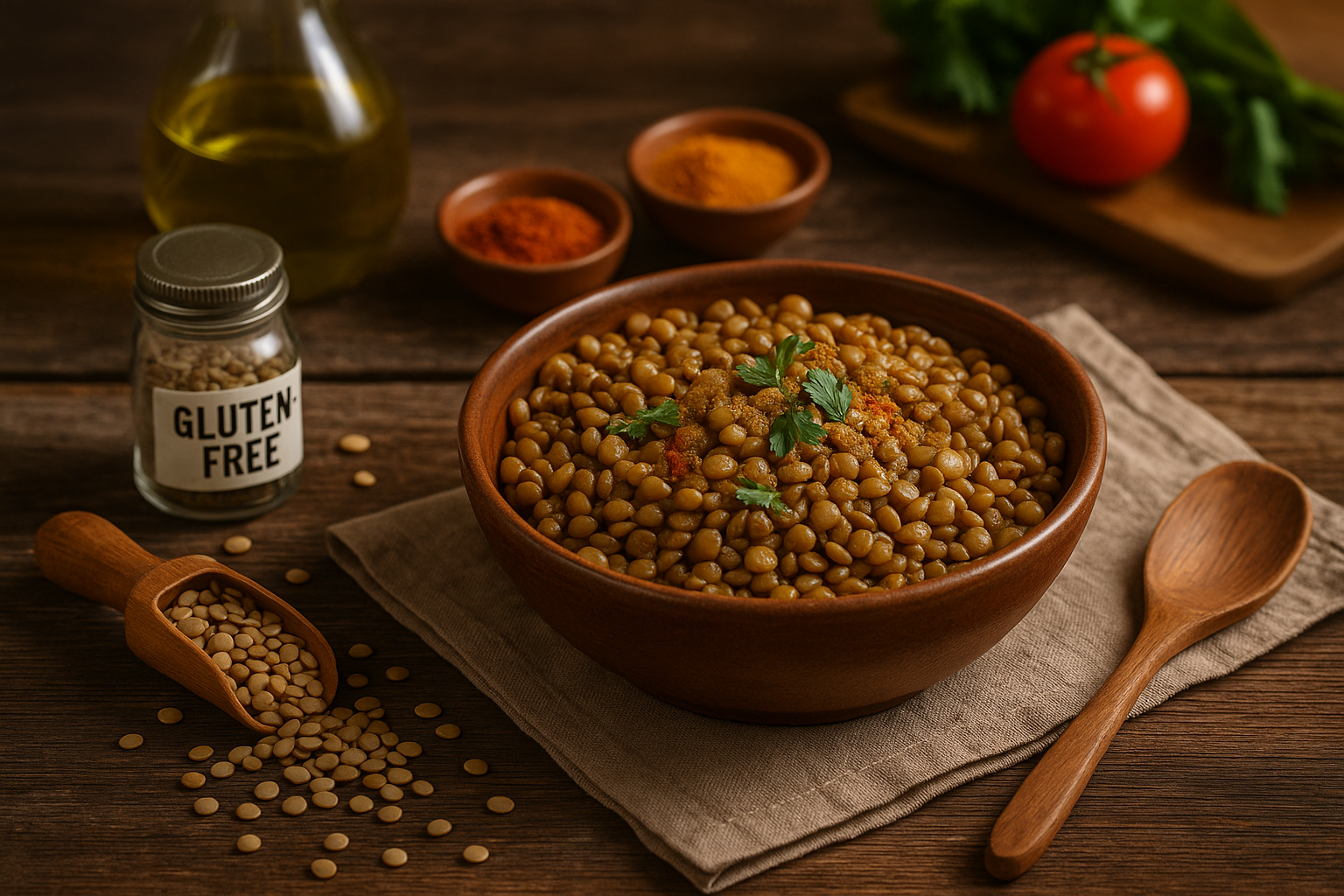I never thought I’d be the person raving about red superfoods, but here I am, completely transformed by these vibrant, nutrient-packed powerhouses. Let me take you on a journey that changed not just my diet but my entire approach to health and wellness.

The Wake-Up Call
It all started on a typical Tuesday morning. I woke up feeling sluggish, my skin looked dull, and I had zero energy to face the day. As I stared at my reflection, I realized something had to change. That’s when I stumbled upon an article about red superfoods, and little did I know, it would be the beginning of a life-altering adventure.
I remember thinking, “Red superfoods? Is this just another health fad?” But something about the vibrant colors and promised benefits intrigued me. I decided to give it a shot—after all, what did I have to lose?
Discovering the Power of Red
My first foray into the world of red superfoods was with a simple handful of goji berries. I’ll be honest—I was skeptical. How could these tiny, wrinkled berries make any difference? But as I continued to explore and incorporate more red superfoods into my diet, I began to notice subtle changes.
It wasn’t an overnight transformation. In fact, for the first week, I didn’t notice much difference at all. But I stuck with it, reminding myself that real change takes time. And boy, am I glad I did!

The Berry Brigade
I started with the basics—strawberries, raspberries, and blueberries. These weren’t just tasty snacks anymore; they became my secret weapons. Packed with antioxidants and vitamin C, these berries not only help improve heart health but also became my go-to choice instead of my usual mid-afternoon sugary snack. The result? More sustained energy and fewer crashes.
One of my favorite discoveries was the versatility of these berries. I created a simple yet delicious smoothie that became my go-to breakfast:
The Berry Blast Smoothie
- 1 cup mixed berries (strawberries, raspberries, blueberries)
- 1 banana
- 1 cup almond milk
- 1 tablespoon chia seeds
- A handful of spinach (trust me on this one!)
To create the perfect red superfood smoothies and shakes, I rely on the powerful Vitamix A3500 Ascent Series Smart Blender. Its versatility and precision make it an essential tool in my superfood journey, allowing me to effortlessly blend even the toughest ingredients into silky smooth concoctions.
- Program Settings: Five program settings (for Smoothies, Hot Soups, Dips & Spreads, Frozen Desserts, and Self-Cleaning) ensure walk-away convenience and consistent results. The A3500 pairs with the Vitamix Perfect Blend App: Unlock the Ascent Series A3500's full potential with 17 programs and 500+ recipes with the iOS + Android app.
- Touchscreen Controls give the machine a sleek silhouette and are easily wiped clean.Electrical Ratings - 120 V, 50-60 Hz, 12 Amps. Cord: 4 feet. HP: 2.2-peak
- You're in Control: Variable Speed Control and Pulse feature let you manually fine-tune the texture of any recipe
- Built-In Wireless Connectivity: The motor base is able to read the container size you’ve chosen and automatically adjust program settings and maximum blending times accordingly. Add a range of compatible container sizes, building a customized blending system designed to fit your needs.
- Programmable Timer: A built-in timer helps avoid over- or under-processing your custom recipes. Set the timer to the length of your blend, and it will turn the machine off automatically. What's in the Box: motor base, low-profile 64 oz. container, low-profile classic tamper, Simply Blending Cookbook
Blending this up in the morning not only tasted great but gave me a noticeable boost in energy that lasted well into the afternoon.
But it wasn’t all smooth sailing. I remember one morning when I was in a rush and decided to skip my berry smoothie. By midday, I felt the difference—I was cranky, unfocused, and craving sugar. That’s when it hit me: these little berries were doing more for me than I realized.
The Pomegranate Epiphany
Then came the pomegranate—oh, what a game-changer! I remember the first time I successfully deseeded one without turning my kitchen into a crime scene. The burst of tart sweetness was like nothing I’d tasted before. But it wasn’t just the flavor that won me over.
I learned about the incredible heart health benefits of pomegranates. Rich in antioxidants, these ruby-red seeds became my new favorite addition to salads and yogurt bowls. I even started drinking pomegranate juice (in moderation, of course) as a refreshing alternative to my usual afternoon coffee.
For those days when I crave fresh pomegranate or beet juice, the Breville BJE830BSS Juice Fountain Cold XL Centrifugal Juicer is my go-to appliance. Its cold spin technology and extra-wide chute make juicing red superfoods a breeze, preserving their nutritional value and vibrant color.
- The Breville Juice Fountain Cold XL features a bigger 3.5 inch feed chute and can extract 70 fl oz of nutrient rich juice up to five times faster than a 'cold press' machine; Juicer equipped with Cold Spin Technology and Noise Reduction Technology
- COLD EXTRACTION SYSTEM: A Breville juicer with Cold Spin Technology and an Italian-made precision mesh filter, allows you to avoid damage to vitamins and minerals from heat and processing
- SHORT PREP TIME: The Breville Juice Fountain Cold XL's unique 3.5 inch extra wide chute feed allows you to juice whole fruits and vegetables without pre-cutting
- SPACE SAVING DESIGN: With the pulp bin located behind the product base, the Juice Fountain Cold XL features a new and unique space saving design for a better use of your countertop space
- NOISE REDUCTION TECHNOLOGY: Imagine great performances that’s easier on the ear; Juicing on quiet setting reduces mechanical noise by 40%
There was this one time when I was feeling particularly stressed at work. Instead of reaching for my usual stress-relief candy, I munched on some pomegranate seeds. To my surprise, the act of slowly eating each seed, savoring the burst of flavor, became a mindful moment that actually helped me relax.

The Beet Goes On
Let’s talk about beets. I’ll admit, these weren’t my favorites at first. The earthy taste was a bit overwhelming, and I had no idea how to prepare them. But after learning about their incredible benefits for stamina and blood flow, I decided to give them another shot.
I started small, adding a bit of grated raw beet to my salads. Gradually, I experimented with roasting them, which brought out their natural sweetness. Now, I can’t get enough of them! My favorite way to enjoy beets is in this simple yet delicious salad:

Roasted Beet and Goat Cheese Salad
- 2 medium beets, roasted and diced
- 2 cups mixed greens
- 1/4 cup crumbled goat cheese
- 1/4 cup chopped walnuts
- Balsamic vinaigrette to taste
This salad not only looks gorgeous but provides a perfect balance of flavors and textures. Plus, I feel like I’m giving my body a real boost of nutrients with every bite.
I have a funny story about beets. I was so excited about their benefits that I went a bit overboard one day, eating a large serving of roasted beans. The next morning, I had a moment of panic when I thought something was seriously wrong with me—until I remembered the beets! Let’s just say, if you’re new to beets, start small and work your way up!
Superfood Powders: My Secret Weapon
In my quest for convenient ways to pack more red superfoods into my diet, I discovered superfood powders. At first, I was skeptical—how could a powder compare to fresh fruits and vegetables? But on busy days when I didn’t have time to prepare elaborate meals, these powders became my go-to solution.
I found the Peak Performance Organic Reds Superfood Powder to be a game changer. With 25+ organic ingredients, including acai, pomegranate, and raspberry, it was like having a whole array of red superfoods in one scoop.
My favorite way to use this powder is in a simple morning shake:
Red Superfood Power Shake
- 1 scoop of red superfood powder
- 1 cup unsweetened almond milk
- 1/2 banana
- A handful of ice
This quick shake gives me a boost of energy and nutrients, especially on mornings when I’m rushing out the door.
I’ll never forget the time I was running late for an important presentation. I didn’t have time for breakfast, so I quickly whipped up this shake and drank it on my commute. Not only did it keep me full, but I felt focused and energized throughout my presentation. It was a small win, but it made me realize how much my new habits were supporting me in all areas of life.
- Don’t be fooled. Not all supplements are the same. Many contain weak and ineffective ingredients. Peak Performance uses two widely regarded natural ingredients. Our Citrus Bergamot extract is a 10:1 ratio, meaning 10 grams of the plant are used to make 1 gram of extract—resulting in a more concentrated and effective supplement
- Great for men and women
- Natural vs Synthetic: Synthetic supplements are often less bioavailable, meaning they are not as easily absorbed or utilized by the body. Studies suggest adaptogenic and antioxidant benefits from natural herbal supplements. Our ingredients are carefully chosen and third-party tested for purity
- Vegan & Allergy-Free: Free from soy, milk, egg, shellfish, corn, wheat, and peanuts. Contains NO gluten or preservatives. Manufactured under strict GMP regulations in the USA
- Over 1 Million Customers + 1-for-1 Donation To Vitamin Angels. We’ve served over 1 million customers and proudly donate one unit per purchase to Vitamin Angels, providing at-risk children with essential nutrients
Beyond the Fruit Bowl
As I delved deeper into the world of red superfoods, I realized it wasn’t just about fruits. I discovered the joy of red spinach, which added a beautiful color to my salads while packing a nutritional punch. Red carrots became a staple in my roasted vegetable meals, adding a touch of sweetness and a hefty dose of lycopene.
One surprising discovery was red bell peppers. I’d always opted for the green ones, not realizing that the red varieties are actually riper and contain more nutrients. Now, they’re a staple in my stir-fries and as a crunchy snack with hummus.
I started experimenting with different ways to incorporate these vegetables into my meals. One of my proudest creations was a red superfood soup—a blend of roasted red peppers, tomatoes, and beets, topped with a dollop of Greek yogurt and a sprinkle of pomegranate seeds. It was a hit at a dinner party I hosted, and I felt a sense of pride in sharing my newfound passion with friends.
The Challenge of Staying Natural
One hurdle I faced in my red superfood journey was avoiding added sugars and preservatives. It was eye-opening to realize how many “healthy” products were actually loaded with unnecessary additives. I learned to read labels carefully and opt for whole, unprocessed foods whenever possible.
For example, instead of buying pre-made trail mixes with dried fruits (often containing added sugars), I started making my own. A simple mix of raw nuts, goji berries, and a sprinkle of cacao nibs became my favorite afternoon pick-me-up.
This newfound awareness spilled over into other areas of my grocery shopping. I started paying more attention to ingredient lists across all products, not just my red superfoods. It was a bit overwhelming at first. I remember standing in the store aisle, feeling frustrated as I realized how many of my go-to products were filled with things I couldn’t pronounce. But over time, it became second nature, and I felt empowered knowing exactly what I was putting into my body.
The Ripple Effect
What started as a simple diet change soon began to affect other areas of my life. I noticed my skin looking clearer and more radiant. My energy levels stabilized, and I found myself sleeping better at night. Even my workouts seemed easier—I had more stamina and recovered faster.
But perhaps the most significant change was in my overall outlook. Taking control of my nutrition made me feel empowered. I was no longer at the mercy of afternoon slumps or constant cravings. I felt in tune with my body in a way I never had before.
This newfound energy and positivity started to influence my relationships and work life too. I found myself more patient with my family, more creative in my job, and more open to new experiences. It was as if by nourishing my body, I had unlocked a better version of myself.
Overcoming Obstacles
Of course, it wasn’t always easy. There were days when I craved my old comfort foods or felt too tired to prepare a nutrient-rich meal. I remember one particularly stressful week when I slipped back into old habits, reaching for convenience foods and skipping my red superfood routine.
But here’s what I learned: progress isn’t about perfection. It’s about consistency and getting back on track when you veer off course. After that week, instead of beating myself up, I gently eased back into my routine. I reminded myself of how good I felt when I nourished my body properly.
I also faced skepticism from friends and family. “You’re spending how much on goji berries?” they’d ask. Or, “Is this just another fad diet?” Their doubts sometimes made me question my choices. But as they saw the positive changes in me—my improved mood, my glowing skin, my increased energy—many of them became curious and even asked for advice on incorporating red superfoods into their own diets.
Spreading the Red Superfood Love
As my passion for red superfoods grew, I found myself wanting to share this knowledge with others. I started a small Instagram account documenting my meals and sharing recipes. To my surprise, people were interested! I connected with a community of like-minded individuals, all on their own health journeys.
This led to some unexpected opportunities. I was invited to speak at a local wellness event, sharing my story and favorite red superfood recipes. Standing there, sharing my journey with a room full of people eager to learn, I felt a sense of purpose I hadn’t experienced before. It made me realize that by taking care of myself, I had inadvertently positioned myself to help others too
Your Turn to Go Red
As I reflect on my journey with red superfoods, I’m filled with gratitude for the positive changes they’ve brought to my life. If you’re feeling stuck in a rut or just looking to boost your health, I encourage you to give these vibrant foods a try. Start small—maybe add some berries to your breakfast or experiment with a new red vegetable in your dinner.
Remember, it’s not about perfection. It’s about making small, sustainable changes that add up over time. My red superfood journey has taught me that true health isn’t about restrictive diets or miracle cures. It’s about nourishing your body with real, whole foods and listening to how it responds.
Here are a few tips to get you started:
- Experiment with different red superfoods to find your favorites.
- Don’t be afraid to try new recipes or preparation methods.
- Listen to your body—notice how you feel after incorporating these foods.
- Be patient; lasting change takes time.
- Share your journey with others—you might inspire someone!
So, are you ready to add a little (or a lot) of red to your plate? Trust me, your body will thank you. And who knows? You might just find yourself writing your own Red Superfoods success story someday. Here’s to your health and to the vibrant life that awaits you!
Remember, every small step counts. Whether it’s adding a handful of berries to your morning routine or trying a new red vegetable each week, you’re moving in the right direction. Embrace the journey, celebrate your progress, and most importantly, enjoy the delicious and nutritious world of red superfoods!

*We may earn a commission for purchases made using our links. Please see our disclosure to learn more.






